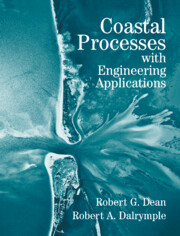Book contents
- Frontmatter
- Contents
- Preface
- Acknowledgments
- PART ONE INTRODUCTION TO COASTAL PROCESSES
- PART TWO HYDRODYNAMICS OF THE COASTAL ZONE
- PART THREE COASTAL RESPONSE
- PART FOUR SHORELINE MODIFICATION AND ANALYSIS
- 11 Beach Fill and Soft Engineering Structures
- 12 Hard Engineering Structures
- 13 Tidal Inlets
- 14 Shoreline Management
- Author Index
- Subject Index
12 - Hard Engineering Structures
Published online by Cambridge University Press: 29 May 2010
- Frontmatter
- Contents
- Preface
- Acknowledgments
- PART ONE INTRODUCTION TO COASTAL PROCESSES
- PART TWO HYDRODYNAMICS OF THE COASTAL ZONE
- PART THREE COASTAL RESPONSE
- PART FOUR SHORELINE MODIFICATION AND ANALYSIS
- 11 Beach Fill and Soft Engineering Structures
- 12 Hard Engineering Structures
- 13 Tidal Inlets
- 14 Shoreline Management
- Author Index
- Subject Index
Summary
Following the devastating 1962 northeaster along the East Coast of the United States, a groin field was constructed at Westhampton Beach, Long Island, New York, with a very deleterious effect on the downdrift (west) beaches. This shore protection project was planned to include a beach fill and to extend to the west to Moriches Inlet. For various reasons, the western part of the groin field was never completed, nor was the beach fill placed. A total of 11 groins were constructed in 1966 and 4 more in 1970 with the most westerly of these located approximately 2.3 km east of Moriches Inlet. The rather substantial net westerly longshore sediment transport began filling the easterly groins with an associated deficit of sand experienced in the 2.3-km gap between the groin field and the eastern jetty of Moriches Inlet. (Excellent reviews of the background for this area are provided by Heikoff 1976 and Nersesian, Kraus, and Carson 1992.) As a result of the erosional stress downdrift of the groins, the barrier island was breached in 1980. By the time the breach was repaired in 1981, it had grown to 1000 m in width and required 980,000 m3 of sand to close (Schmeltz et al. 1982). A second breach occurred during a severe storm in November 1992. This breach also grew, destroying houses while decisions were pending for closure.
Since the construction of the groins, the average shoreline change within the groin field has been a seaward advancement of approximately 80 m; the greatest advancement of 112 m has occurred in the eastern compartment, and the smallest advancement of approximately 15 m within the westernmost compartment.
- Type
- Chapter
- Information
- Coastal Processes with Engineering Applications , pp. 387 - 412Publisher: Cambridge University PressPrint publication year: 2001



